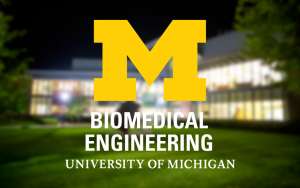Presented By: Biomedical Engineering
PhD Defense: Dominique Smith
Lentiviral gene therapy from multichannel bridges to investigate acute and chronic spinal cord repair

Spinal cord injury (SCI) causes paralysis below the level of injury which, at the cellular level, results from neuron and oligodendrocyte cell death, axonal loss, demyelination, and critically, the limited capacity of spinal cord neurons to regenerate. Although central nervous system (CNS) tissue has the innate capacity to repair the local environment that develops after SCI lacks sufficient factors that promote regeneration and has an abundance of factors that inhibit regeneration. Many strategies have been attempted to aid in the regeneration of CNS tissue, yet re-entry into intact spared tissue remains inadequately low. This is due to the complexity of the spinal cord microenvironment post injury and the barriers that must be addressed to elicit adequate regeneration. The Shea lab has developed multi-channel poly (lactide-co-glycolide) (PLG) bridges to promote spinal cord regeneration and restore functional losses. These bridges are biodegradable and provide a temporary structure that promotes regeneration for between 2 and 6 months post-implantation. The bridges have an interconnected pore structure, that allows infiltration of endogenous cell populations, including macrophages, Schwann cells, oligodendrocytes. Additionally, the bridge mechanically stabilizes the injury with tissue ingrowth and reduces secondary injury and axonal dieback. Longitudinal channels encourage axons to regenerate into the bridge with cells aligned along this major axis. Both motor and sensory axons have been identified in bridge channels. These bridges also serve as a platform for delivery of therapeutics including drugs, cells, and notably lentivirus.
This dissertation investigated the use of lentiviral gene therapy from multi-channel bridges to barriers to regeneration during acute and chronic phases of SCI. We investigated myelination of regenerating axons by over-expression of platelet-derived growth factor-AA (PDGF) and noggin either alone or in combination in an acute mouse SCI model. The combination of noggin + PDGF enhanced total myelination of regenerating axons relative to either factor alone and importantly, enhanced functional recovery relative to the control condition. The increase in myelination was consistent with an increase in oligodendrocyte-derived myelin, which was also associated with a greater density of cells of an oligodendroglial lineage relative to each factor individually and control conditions. We investigated synergistic effects of anti-inflammatory and regenerative factors by bi-cistronic delivery of NT-3 and IL-10 using PLG bridges after acute SCI. The combination of IL-10+NT-3 enhanced axonal growth and oligodendrocyte myelinated axon density significantly over control This resulted in increased locomotor functional recovery compared to IL-10 or NT-3 alone but increased hypersensitivity compared to IL-10 alone. Furthermore, we observed a strong positive correlation between oligodendrocyte myelinated axon density and functional recovery. Lastly, we investigated regeneration using the multi-channel bridge implanted into a chronic SCI following surgical resection of necrotic tissue. We characterized the dynamic injury response and noted that scar formation decreased at 4 and 8 weeks post injury (wpi), yet macrophage infiltration increased between 4 and 8 wpi. Subsequently, scar tissue was resected and bridges were implanted at 4 and 8 wpi. We observed robust axon growth into the bridge and remyelination at 6 months post initial injury. Axon densities were increased for 8 week bridge implantation relative to 4 week bridge implantation, whereas greater myelination, particularly by Schwann cells, was observed with 4 week bridge implantation. Taken together, these results show the bridges as a great tool to manipulate and investigate the spinal cord microenvironment to improve functional outcomes.
This dissertation investigated the use of lentiviral gene therapy from multi-channel bridges to barriers to regeneration during acute and chronic phases of SCI. We investigated myelination of regenerating axons by over-expression of platelet-derived growth factor-AA (PDGF) and noggin either alone or in combination in an acute mouse SCI model. The combination of noggin + PDGF enhanced total myelination of regenerating axons relative to either factor alone and importantly, enhanced functional recovery relative to the control condition. The increase in myelination was consistent with an increase in oligodendrocyte-derived myelin, which was also associated with a greater density of cells of an oligodendroglial lineage relative to each factor individually and control conditions. We investigated synergistic effects of anti-inflammatory and regenerative factors by bi-cistronic delivery of NT-3 and IL-10 using PLG bridges after acute SCI. The combination of IL-10+NT-3 enhanced axonal growth and oligodendrocyte myelinated axon density significantly over control This resulted in increased locomotor functional recovery compared to IL-10 or NT-3 alone but increased hypersensitivity compared to IL-10 alone. Furthermore, we observed a strong positive correlation between oligodendrocyte myelinated axon density and functional recovery. Lastly, we investigated regeneration using the multi-channel bridge implanted into a chronic SCI following surgical resection of necrotic tissue. We characterized the dynamic injury response and noted that scar formation decreased at 4 and 8 weeks post injury (wpi), yet macrophage infiltration increased between 4 and 8 wpi. Subsequently, scar tissue was resected and bridges were implanted at 4 and 8 wpi. We observed robust axon growth into the bridge and remyelination at 6 months post initial injury. Axon densities were increased for 8 week bridge implantation relative to 4 week bridge implantation, whereas greater myelination, particularly by Schwann cells, was observed with 4 week bridge implantation. Taken together, these results show the bridges as a great tool to manipulate and investigate the spinal cord microenvironment to improve functional outcomes.